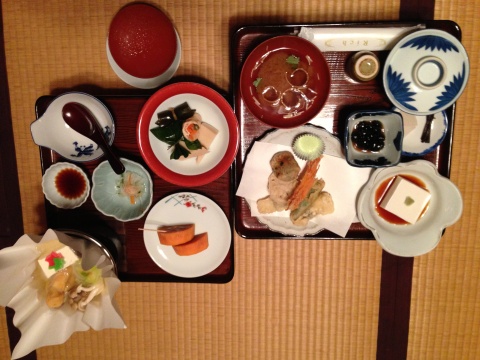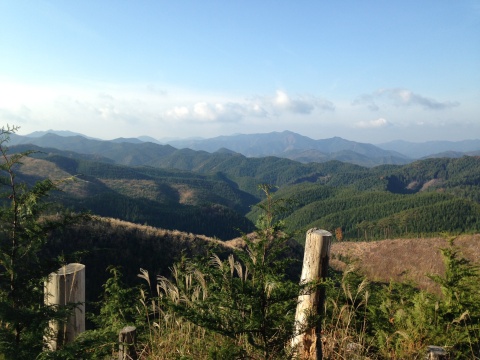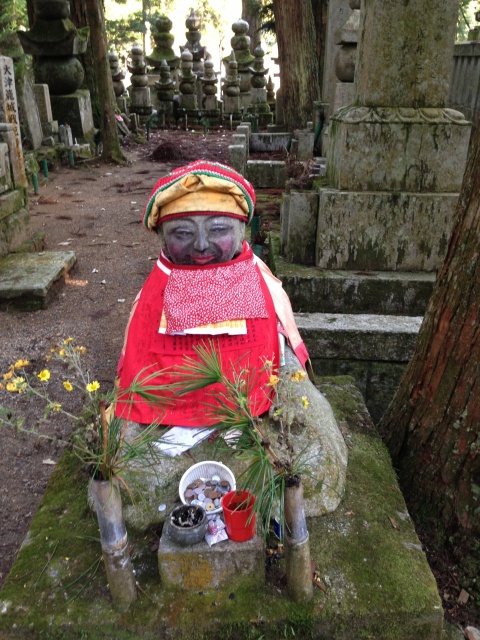Pilgrims / 遍路
November 26, 2013 § Leave a comment
Trampers were emerging from a small path just behind where I took this picture.
They’d scrambled up 24 kilometers of ground. When they reached the parking lot at the top they high-fived one another, took off their packs, and sat down on the concrete shoulder. Koyasan choishimichi is the traditional pilgrims’ approach to Koyasan – home of the headquarters of Shingon Buddhism; this big gate ( 大門; Daimon) marks the point of entry after the long walk up. Koyasan is where it is because the landscape is said to resemble the shape of a lotus; its energy spreads outwards across Japan – a great mandala pattern with its heart smack bang in the middle of Koyasan.
Short on time and willpower, we took the cable car up.
We checked into our temple-stay, took a stroll through town and arrived at the big gate just on time to meet a couple of keen Japanese trampers who’d recently walked the Milford Track. As we talked I secretly compared our national treasures, concluding that while they have the history, New Zealand probably wins out on scenic beauty. The old ill-fitting boot of nationalism tightens its laces in even the most spiritual places.
Here’s something they have that we don’t have:
(Konpon Daito)
Living in Kyoto it’s easy to forget that the old city is not like the rest of Japan. Kyoto is, in some ways, stifled and traditional and incredibly hard to navigate; it has a reputation for being the most traditional of Japanese cities and I’d say (lovingly) that like Paris or New York it’s a snobby old place with two cold shoulders. Every time I venture beyond Kyoto I meet people that are infinitely friendlier, more helpful and more forgiving. In Japan I require endless forgiveness. Unlike Kyoto, Koyasan invites you to participate in tradition but doesn’t make you feel like an unwelcome spectator to something held beyond your reach. Also, infinite forgiveness and uncompromising patience are kinda their thing up there.
There are over 100 temples up in Koyasan and over 50 of those take overnight guests for temple stays. You can book a room at a temple online and most rooms come with a vegetarian dinner and breakfast prepared and served by the monks. We stayed overnight at Saizen-in. One of the monks who brought us our dinner came from Fukushima. There was an uncomfortable moment when, with my terrible Japanese and his limited English, I mistakenly thought he was explaining that his parents had been killed by the tsunami. But no. No no no. Everything was okay, he said. They were fighting, he said. His friends and his brother and his parents are all up there in Fukushima fighting.”That’s good. Isn’t it?” I said. “That’s really good.” I didn’t have the Japanese for that one. Or probably the English either.
Everything about staying at the temple was simple and easy – except for dinner – which consisted of sets of immaculately prepared, complex and delicate dishes. If you were the dramatic sort you might weep into your bowl and declare your life complete. We just ate and took photos of each other eating.
Here is some bad food photography to serve as proof:
This is a meal for one person. Sake and tea are served on another tray (not pictured but implied by the quality of the photograph).
Morning prayers start at 6:30 am. Be early! As with many things in life, the later you arrive the further you will sit from the heater. My prayers brought me to the conclusion that I will never be a buddhist. Despite some leanings in high-school (don’t we all experiment?) I’ve realised it’s not for me. I don’t have the kind of mind strong enough to remain focused during meditation. My thoughts went parading wholesomely back and forth from one frozen ear to the other. But they weren’t soldiers. They were more like poorly trained drum majorettes dropping their sticks and tripping all over themselves: am I doing it right? I thought. Is this right?/I should think about giving more of myself/I am a terrible person/I am sending my love to my family and my parents and my sisters and all of my aunts and uncles, and now to each of my friends individually / Oh I wonder how she is?/ that man in front of me looks like he’s pretending to know what he’s doing but he really doesn’t/ I’m gonna cough now/how long do I cough for before I should get up and leave/it must be the incense/maybe I don’t really like incense that much/eternal love eternal love eternal flame/what ever happened to the Bangles, they were a good band/they must think we are so silly pretending to understand what this is all about/my life lacks a spiritual path/ I really dislike my job/ maybe I just need more spiritual stuff/ can’t we all just read literary theory and get along?/ that trickster psychic in Central Park said I knew the spiritual way and my third eye was opening/is he done now/oh crap I never thought about each of my friends individually/eternal love eternal love.
It was no good. My own personal versions of meditation are a lot simpler: walk or read. I can’t find the Virginia Woolf quote now or remember where it’s from, but somewhere she wrote that the act of reading is the ultimate suspension of the ego. It might have been in her diaries? While reading, immersed utterly in a fictional universe, our thoughts about ourselves and our own lives cease ; our inner voices shut up. Walking too, can shut you up for a bit if you do it right.
After a communal breakfast with other guests P and I set off into the woods. We’d decided to do the Koyasan Woman’s Pilgrimage Walk, tracing the steps of old female pilgrims. Historically women were not permitted to enter the sacred grounds of Koyasan. Devout woman would skirt the edges of the place, looking in on the important temples and making their prayers from afar. I wondered if, as in the Catholic church, there were stories of women who disguised themselves as men in order to gain access to the closely guarded secrets of their faith.
We tried to skirt the edges but we went over into a valley. We were discussing GRIT very deeply (did we have it? Why didn’t we have it?). Lost in conversation, we forgot to keep our eyes out for trail markers. What began as a two and half hour morning stroll became a four hour ramble through unkempt forest. We were happy enough. Doesn’t every unplanned journey begin with a single misplaced step? The step might lead you to a point where your path ends abruptly, disappearing over a ledge and dissolving into a haze of pines. You might hear a chainsaw in the distance, softly calling you to commerce.
When we turned back to retrace our steps it became immediately obvious that what we’d been following didn’t actually look much like a pathway. Everything is obvious in retrospect. A lesson learned. We had flasks of coffee and each other. We wren’t too fussed.
We popped out of the woods near the gate to Okunoin – Japan’s largest and most important cemetery. Here we wondered around in the low, late light peering at tombs and looking in on things.
A woman carried a bucket of water towards a stone she’d be cleaning. People prayed and performed small rituals of their own.
It’s hard to be in a place of massive cultural significance and be disconnected from it; I couldn’t recognise the histories and lives of the religious and political figures buried or commemorated at Okunoin. That old cemetery in Paris fascinated me for hours because I know all the stories of its dead. In Okunoin I liked the trees and the light. What I’ve noticed when I travel in Japan is that stories make a landscape look more beautiful. Horses too. It’s no great surprise to learn that the more you know about a place and where it falls in a narrative, the more invested you are in it. But it’s striking to come up against this lesson over and over again.
All you need of course is one small knot to weave you into a bigger story; after the cemetery we dropped into a temple (I’m miffed that I didn’t take note of the name) exhibiting all kinds of memorabilia related to troops who served during the Japanese occupation of Myanmar (then Burma). I could easily have spent hours in there looking at the rows of black and white photographs, and poring over the letters and diaries; I was fascinated because it’s a story I know something about and it provided a link between my passion (for dusty archives created in times of occupation) and theirs. Underneath the temple you could walk into a dark isolation corridor. You held a railing and moved along in pitch blackness. When you’d fully rounded the corner you came into a small, lit cavern and looked at a statue of the reclining Buddha. Only then, underground and alone and totally unexpected, did I feel the odd and brief sensation that I was a tiny point standing at the very centre of something much bigger than myself. There was that woman in Central Park who told me that my third eye was opening. But then, she also said one could never be forgiven for the cruelty of breaking a heart, so I chose not to trust her. After a moment the silly feeling was gone anyway, and I groped in the darkness for the handrail that would guide me to the exit.









Leave a comment